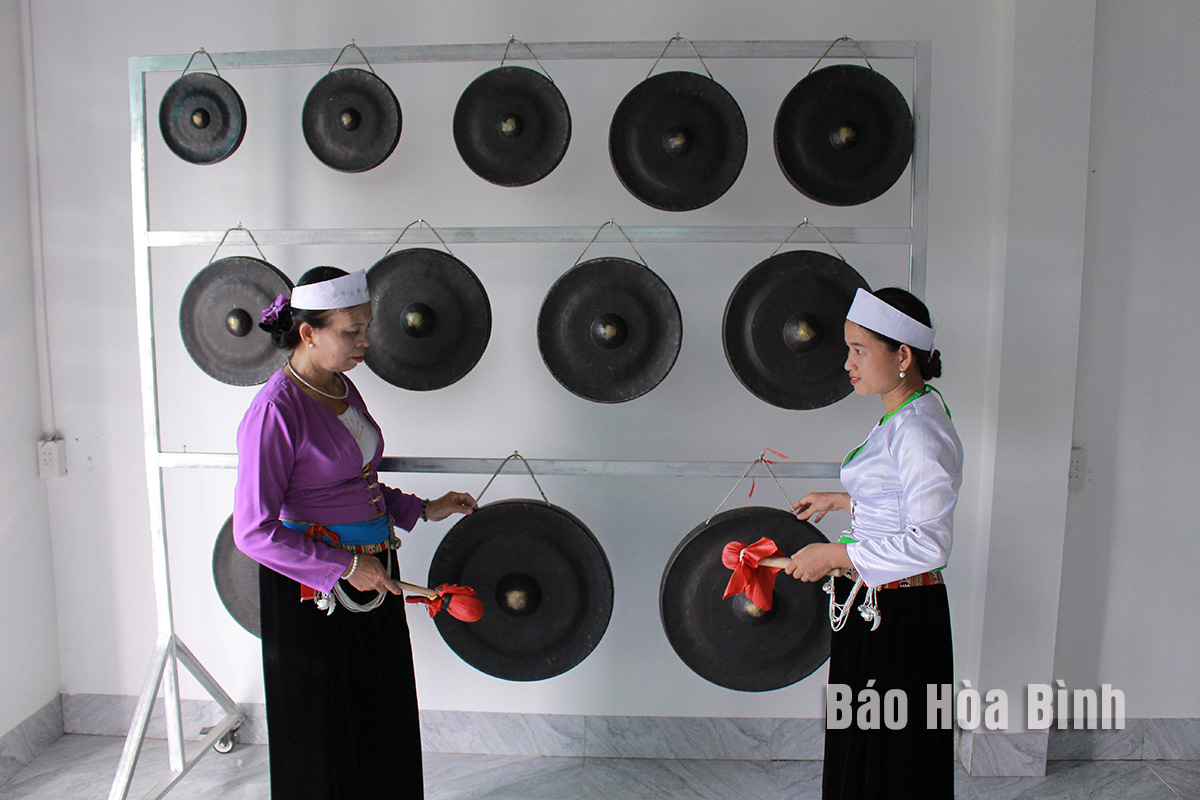
Lac Thinh commune, Yen Thuy district, is home to 1,635 households, of which 82% are ethnic minorities, mainly Muong people. In recent years, the commune has prioritised to developing cultural clubs, aiming to both enrich the community's spiritual life and preserve traditional cultural values.
Artist Quach Thi Kieu (left) guides and teaches Muong gong playing techniques to club members.
With the view that "people stay alive when their culture
stay alive,the local authorities have paid heed to preserving and promoting
the Muong folk cultural identity. In this spirit, the Women's Union of Lac
Thinh commune has encouraged residents to wear traditional Muong attire during
festivals and community events. They also established two cultural preservation
clubs in Trac and Dinh Van hamlets.
With 31 members when founded in 2021, the Trac hamlet club now has 49,
including both male and female artisans. It maintains practices of traditional
Muong music, dance, and cultural performances every Saturday and Sunday. These
activities have garnered attention from professional units at district and
provincial levels. The club has been invited to participate in numerous
cultural exchanges and festivals, including performances for Vietnam's national
television.
Quach Thi Kieu, head of the Trac hamlet club, explained that members are taught
to play traditional Muong instruments, sing folk songs, and perform Muong
dances. The club also holds workshops on traditional brocade weaving and the
significance of traditional Muong clothing.
In November 2022, recognising the success of the Trac hamlet club, the communal
Women's Union established anotherclub in Dinh Van hamlet, with 45
members. The club has been actively involved in local cultural exchanges,
festivals, and workshops, helping to preserve and promote Muog traditions.
The establishment and development of the club model are of significance in
preserving and promoting the cultural heritage value, thus creating best
possible conditions for ethnic people to directly engage in protection and
promotion as well as enjoy results of these activities. foster a sense of
community, ensuring that cultural traditions are passed down to future
generations.
Hoa Binh province has carried out multiple programmes and initiatives to revive its cultural heritage which has gradually fallen into oblivion through the ebbs and flows of history.
The most prominent and defining feature in the prehistoric era of Hoa Binh is the Hoa Binh Culture. The Culture was first discovered in Hoa Binh. The significant prehistoric culture represents not only Vietnam but also Southeast Asia and southern China. Through excavations of cave sites in the limestone regions of Hoa Binh, French archaeologist M. Colani introduced the world to a "Stone Age in Hoa Binh province – Northern Vietnam" in 1927. On January 30, 1932, the First Congress of Far Eastern Prehistorians, held in Hanoi, officially recognised the Hoa Binh Culture.
Known as the "Land of Epic History”, Hoa Binh province, the gateway to Vietnam’s northwest, boasts a strategic location and a unique cultural tapestry woven by its ethnic minority communities.
The People's Committee of Luong Son District recently held a ceremony to receive the certificate recognizing Sau Communal House in Thanh Cao Commune as a provincial-level historical and cultural site.
Recognising the importance of cultural heritage preservation in protecting and promoting the value system of Vietnamese culture, and serving socio-economic development in the new period, Party committees and local administrations in Hoa Binh province have identified it as a key task in the cultural development strategy. The province has been making efforts in mobilising resources, creating consensus among people and engaging ethnic communities in preserving and promoting cultural identity.
Hoa Binh province has captured growing attention both domestically and internationally for its distinctive cultural heritage and rich history. Most notably, it has been renowned for its famous Hoa Binh culture, considered the cradle of ancient Vietnamese civilisation. Looking ahead to significant milestones in 2025 and the 140th anniversary of province establishment in 2026, Hoa Binh Newspaper presents a comprehensive overview of the province's development across economic, social, cultural, tourism, and security domains.



